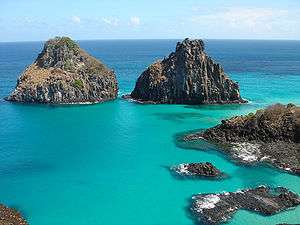Tied island
Tied islands, or land-tied islands as they are often known, are landforms consisting of an island that is connected to land only by a tombolo: a spit of beach materials connected to land at both ends. St Ninian's Isle, in the Shetland Islands off the north coast of Scotland, is an example of this; it was once an island but is now linked to the Mainland. Other examples include: Maury Island, Washington in the Puget Sound, Coronado, California and Nahant, Massachusetts in the U.S.; Barrenjoey, New South Wales in Australia; and Wedge Island in Western Australia.
The Isle of Portland is also referred to as a tied island, although geographers now believe that Chesil Beach (which connects the island to the mainland) is a barrier beach that has moved eastwards, rather than a tombolo, which would have been formed by the effect of the island on waves.
See also
-
 Islands portal
Islands portal
References
- Glossary of geology and related sciences. Jesse V. Howell, American Geological Institute. 1962.
- Some Coastal Landform Definitions. Matthew Flinders, Villanova College, Queensland.
External links
 Media related to Tied islands at Wikimedia Commons
Media related to Tied islands at Wikimedia Commons

